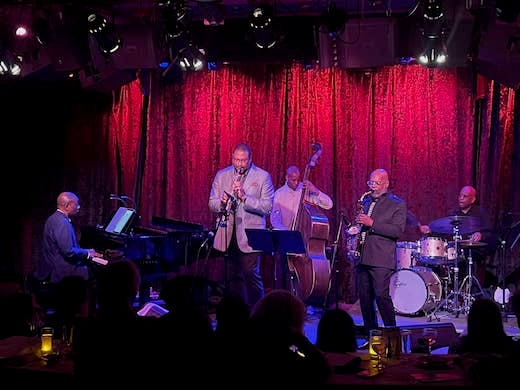Even as the Birthdays Pile Up, the Coltrane Tributes Never Get Old
Birdland, with the help of producer Milan Simich, has been honoring Coltrane’s birthday for 22 straight years. It’s to the saxophonist’s credit that his catalog is copious enough for the Birdlanders to keep finding new things to play in his honor.

John Coltrane Revisited
Birdland
Through September 23
If you ask people whether they like Duke Ellington or Louis Armstrong, the answers are bound to be straightforward — and almost certainly involve “yes.” Ask whether they like the music of John Coltrane, and the answer might be a little more complex. Coltrane’s canon is so vast and covers so much musical territory that even hardcore jazz fans might be forgiven for not embracing all of it.
As for me, there are Trane albums I respect more than actually love — even after listening all my life, it’s still hard for me to get through the 1961 Vanguard sessions with “Chasin’ the Trane” and some of the more extreme music he reached for near the end of his short life.
On the other hand, even non-jazz fans can find a way into his more populist albums — like the three masterpieces of 1963, “Duke Ellington & John Coltrane,” “Ballads,” and “John Coltrane & Johnny Hartman.” Still, it isn’t only Coltrane’s most accessible material that resonates with me. Both of what might be called his more spiritual larger works, “A Love Supreme” and “Ascension,” have a way of leading the listener even through the more so-called difficult moments in a way that makes both musical and even moral sense.
Birdland, with the help of producer Milan Simich (also a respected author and younger brother of a late poet laureate, Charles Simic), has been honoring Coltrane’s birthday — he would have turned 97 on September 23 — for 22 straight years. It’s to Coltrane’s credit that his catalog is copious enough for the Birdlanders to keep finding new things to play in his honor.
For this year’s tribute, the producer chose to focus on a very specific period: the two years between the springs of 1959 and 1961. In these months, he made his final break with Miles Davis and began to fully come into his own as both a bandleader and a composer, which is vibrantly documented on seven albums he made while under contract to Atlantic Records.
The Coltrane Revisited ensemble this is year is led by tenor saxophonist Jimmy Greene and alto saxophonist Greg Osby — as Coltrane scholar supreme Lewis Porter has noted, whenever Coltrane felt the need for a second horn in his group, he reached out to another saxophonist, rather than a trumpet or trombone — with a rhythm section of pianist James Weidman, bassist Lonnie Plaxico, and drummer Billy Drummond.
The opening set began, even as does the classic album “Coltrane Plays the Blues” — a 1962 release of 1960 sessions — with “Blues for Elvin,” named for Coltrane’s longtime drummer, Elvin Jones. Blues were a recurring theme throughout the evening; following “Liberia,” Coltrane’s 1960 response to former employer Dizzy Gillespie’s “Night in Tunisia,” which sounded very exotic, the quintet moved on to “Some Other Blues.” The latter contained some of Mr. Osby’s most inspired and energetic playing of the night.
“Like Sonny,” Coltrane’s homage to his colleague Sonny Rollins, is a catchy, kaleidoscopic tune that seems to turn in on itself. It always seemed like a circular melody to me, though it’s set in 4/4. It made a perfect intro to two of the numbers in which Coltrane helped create the jazz waltz, Frank Loesser’s “Inch Worm” — which Coltrane first performed after this period, in early 1962 — and Richard Rodgers’s “My Favorite Things.”
Just as Coltrane had simplified “Tunisia” to transform it into “Liberia,” he also reduced these two show tunes to their most basic components, concentrating on the main melody of each, more or less ignoring the bridge to “Favorite Things” and the very important contrapuntal tune of “Inch Worm.” In the process, he also essentially reintroduced the soprano saxophone into jazz, as Mr. Greene showed when he switched to the smaller horn — which, thanks to Coltrane, has become a standard double for tenor players — for these two numbers.
They ended as they began, with a minor blues dedicated to a collaborator in the rhythm section, “Mr. PC,” named for Paul Chambers, who worked side by side with Coltrane in the first great Miles Davis Quintet. This highly Gospel-ized melody makes for an exciting finale, opening with an extended intro by Mr. Plaxico. The two saxophonists outdid themselves in their individual solos, and then surprised us all with a fruitful trade of fours at the end, which amounted to a conjoined solo. The tune and the first set ended with a thunderous percussion exhibition by Mr. Drummond.
I’ll be back next year; even after 22 years of birthday tributes, the deep well of Coltrane’s music is far from running dry.

